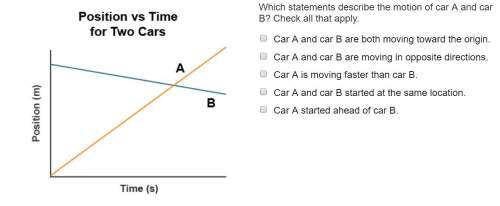
Physics, 22.08.2019 21:30 sydchann582
The formula ds = dq/t makes it look like a system can only increase its entropy by absorbing heat. you must however remember that this equation is only true for reversible processes. entropy can change for a system without absorbing any heat. consider the following scenario. you are given an insulated container with two compartments. the whole container is at the temperature t which remains constant. one compartment has a volume v1 and has n1 moles of an ideal gas. the other has n2 moles of a different ideal gas in a volume v2. the partition between the compartments is punctured. find the entropy increase for this process. this process is clearly not reversible - the pressure for example would be poorly defined. do not use the sakur-tetrode formula. calculate the entropy increase by considering a reversible process where each gas expands isothermally, one from v1 to v1 + v2 an the other from v2 to v1 +v2. first just take one gas expanding from v1 to v1 +v2 at constant t. since t is constant you know that ∆u = 0 and hence ∆q = ∆w. you can easily find w from the pressure work and hence the increase in entropy for this gas. note very carefully the logic of this calculation. we have:
(a) an irreversible process: gas 1 and gas 2 rapidly expand into their neighbour’s container. everything is insulated, and there is no change in temperature and no heat flow into the system. in the end we have a volume v1 + v2 filled with the two gases. we cannot use ds = dq/t here because the process is not reversible - it certainly does not go through a series of equilibrium states.
(b) a reversible process where we imagine each gas expanding isothermally and reversibly from their initial volumes to v1 + v2. this reversible process does involve a transfer of heat to both gases. here we can use ds = dq/t.
where we end in cases (a) and (b) is at the same state: two gases in a volume v1 + v2 at a temperature t, so the entropy change must be the same - entropy is a state function. however, note that in case (a) there is no work done and no heat absorbed, whereas in case b there is work done and heat absorbed. this problem is so tricky because we are told the gases are in an insulated container - no heat can flow to them - but we have then turned around and totally violated this prohibition to calculate the entropy change. an analogy with mechanics might be as follows. you have a mass m resting on the perfectly hard ground in london. what is the gravitational potential energy change in bringing it to rest on the perfectly hard ground in canberra? we can take a path that tunnels into the ground in london, passes through the centre of the earth and emerges in canberra. the work against gravity involved in this path is the change in gravitational potential energy, even though it violates the idea of having perfectly har ground. in any case this problem shows that the entropy of a system can change with no heat flow into or out of it - just by mixing.

Answers: 1


Another question on Physics

Physics, 22.06.2019 02:00
In which of the following cases is work being done on an object? question 2 options: pushing against a locked door carrying a box down a corridor pulling a trailer up a hill suspending a heavy weight with a strong
Answers: 1

Physics, 22.06.2019 03:10
Aphysical change is a change in the size, shape,, or stafe of matter true or false
Answers: 1


You know the right answer?
The formula ds = dq/t makes it look like a system can only increase its entropy by absorbing heat. y...
Questions

Biology, 30.08.2019 13:10


History, 30.08.2019 13:10

Chemistry, 30.08.2019 13:10

English, 30.08.2019 13:10

English, 30.08.2019 13:10

Mathematics, 30.08.2019 13:10

English, 30.08.2019 13:10

Mathematics, 30.08.2019 13:10

English, 30.08.2019 13:10

Mathematics, 30.08.2019 13:10

History, 30.08.2019 13:10



Mathematics, 30.08.2019 13:10



Mathematics, 30.08.2019 13:10





